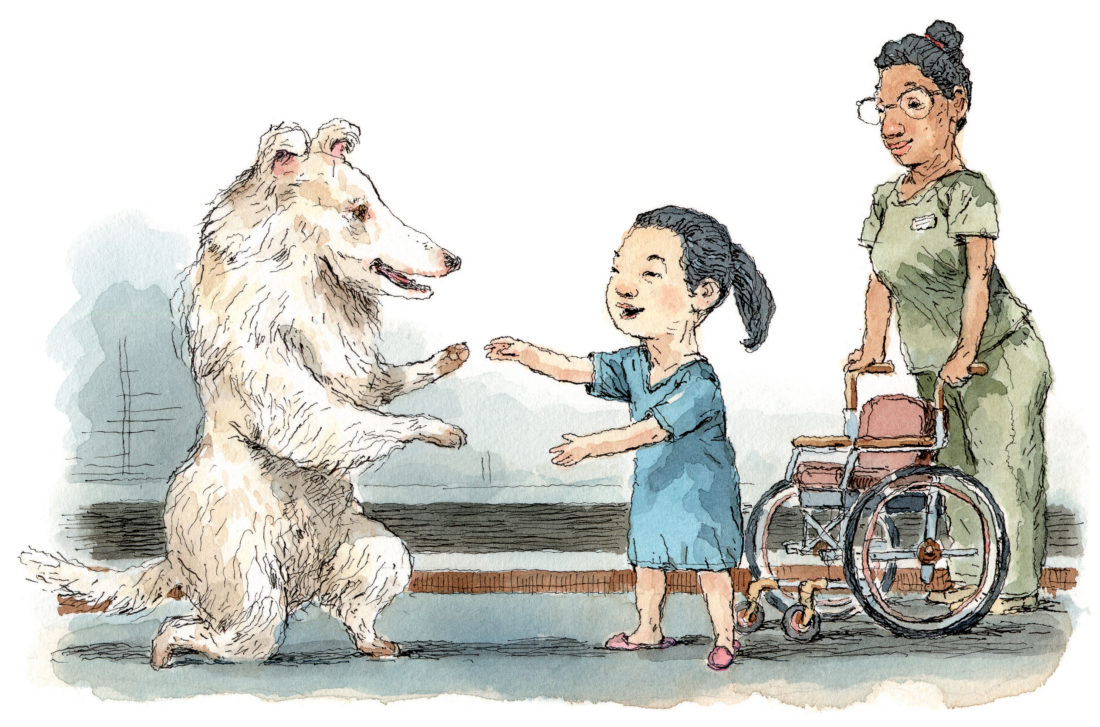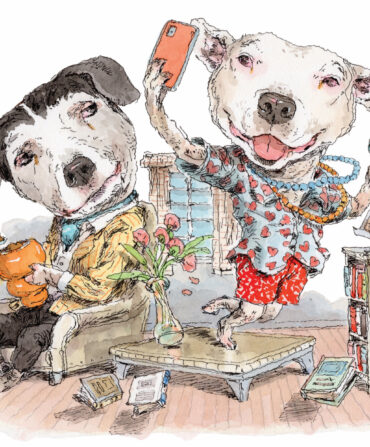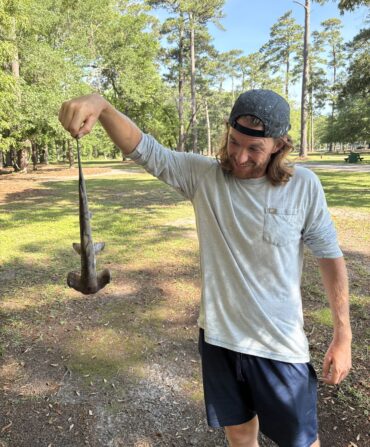Before I knew Lothair existed, before I laid eyes on Lothair and brought Lothair into our home, I knew he was going to be deaf. I also believed in my heart that he would, someday, against seemingly insurmountable odds, become a registered therapy dog to give emotional support to both children, deaf and nondeaf, and adults. I was determined to do it—it’s been documented that some breeders, when a puppy is born deaf or visually impaired, have it put to sleep, because the owner may not want to go to the trouble of training or finding a home for it, or the dog could negatively reflect on breeding stock. If I succeeded, I could show those owners another way.
Lothair, a Shetland sheepdog, was born deaf. I was not. But when I was twelve years old, I lost my hearing when a doctor in my Pennsylvania hometown gave me the antibiotic streptomycin, a possible side effect of which was hearing loss. Within the space of three months—from the time I went to the hospital in June of that year until the time I started back at school in September—I had lost 90 percent of my hearing.
Still, I know what it’s like to be able to hear, which made lipreading easy to pick up quickly, and I learned sign language in college. I decided I wanted to help others like me—I earned advanced degrees, including a master’s in counseling and guidance, and an educational specialist degree from William & Mary in Virginia. For decades, I worked in deaf education.
In 2000, I decided to train my first sheltie, Shiloh, so he could participate in animal-assisted therapy. I had grown up with collies, which are similar to shelties, and I knew that their affectionate, eager-to-please temperaments would be perfect for providing emotional support. The process, though, is intense—the dog must ace thirteen tests, given by a trained evaluator from Therapy Dogs International (TDI), that assess personality, obedience, calmness, and socialization, with people of all ages as well as other therapy dogs. Shiloh passed his evaluation the first time he tried, and over the next eight years, he and I took a journey of joy and happiness, visiting people in such places as hospitals, schools, retirement homes, and libraries. Eventually, I welcomed into my home two more shelties, Molly and Locksley, and they too became therapy dogs in Hampton, Virginia, where my husband and I had moved for his job in the military at Langley Air Force Base.
In 2008, I set my heart on a new goal: acquiring a deaf sheltie. I knew from my years working in deaf education that deaf children would benefit greatly from bonding with a deaf dog—they would see that the dog understood sign language, and they could both identify with and take comfort in that. I contacted a reputable breeder of Shetland sheepdogs and asked her to put out a call to her contacts for anyone who might have a deaf sheltie. A show-dog breeder in North Carolina responded, and we brought Lothair home that October.
Lothair came to us when he was three months old. He is a double merle, the result of two blue merle shelties being bred together—an action generally considered unethical, since the resulting litter often includes a dog born white (not a recognized show-dog color), as Lothair was, due to a genetic mutation, and at a high risk for hearing and visual impairments. I named him for a medieval French king I had once read about—even at that young age, he already had the stance and dignity of royalty.
The commands needed to communicate with the pup required a special kind of patience. At first, I enrolled Lothair in two dog obedience schools in Hampton, but the instructors were unfamiliar with how to teach a deaf dog. I thought back to my own experience and knowledge. Just like deaf children, Lothair would need to learn through his eyes, and not his ears—he would be seeing voices. So I began teaching him American Sign Language (ASL), one sign at a time, in the same manner I had helped deaf children acquire language: showing the object—say, a biscuit—or performing the act, such as getting his leash to “go for a walk.”
Neither his breeder nor the instructors at the obedience schools had any hope Lothair would develop the skills needed to pass the stringent TDI evaluation. But I knew I could prove them wrong. My maxim is “All dogs can learn, but not in the same way, or on the same day.” The basic principles of training a deaf or nondeaf dog are the same: patience, control, motivation, and love.
Within two weeks, Lothair was responding to the signs for food (or “eat”), biscuit, go for potty, and sit. And over the next three months, he learned and responded to the signs for come, stay, water, good boy, time to go to work, no, stop, watch me, wait, apple (a treat), “chick-chick” (I used boiled chicken breast as a positive reinforcement), tickle-tickle (for playtime), and go for a walk. When I wanted to praise him, I shook my hands in the air near my face while smiling—the ASL sign for “well done.” I also enrolled Lothair at puppy playdates where he interacted with other puppies, for a therapy dog must develop good socialization skills. While I was teaching Lothair ASL, my other two shelties also picked up the signs.
When Lothair was one, I decided he was ready to be evaluated by TDI. He passed all thirteen test areas on his first try, and he received his American Kennel Club Good Citizen Award and certification as a registered therapy dog. In the ten years since, Lothair has made more than 750 pet therapy visits to local hospitals, including to the one at Langley, where I began an animal-assisted therapy program in 2009; schools, where he serves as a companion to both deaf and nondeaf children as they read; library reading programs; retirement and rehabilitation facilities; and community events.
So many moments with Lothair have touched my heart. The young girl with limited mobility at the Langley hospital, for instance, whose mother said she had never shown interest in dogs; yet the girl reached down from her special-needs stroller to pet Lothair, and kept her eyes on him as we moved away. Then Lothair stopped, turned around, and looked at her, and the child slowly got out of her stroller and walked toward us, her hands held out for him. Or the little boy with Down syndrome, who would read only to Lothair. Or the man at a rehab hospital recovering from a stroke, who regained strength in his hand and arm by stroking Lothair.
In return for his service, TDI awarded Lothair its highest honor—a gold pin when he achieved five hundred documented visits—and he has also received the Air Force ACC/SG Real Pro Award for his work at Langley (a recognition typically given to military staff) and in 2017 the Virginia Veterinary Medical Association Animal Hero Award, an honor bestowed to only one dog each year from the various service, police, assistance, and therapy canine professions across the state. Newspapers local and beyond have featured his works—not bad for a dog most doubted.
Indeed, here is a dog who has overcome the barrier of deafness, who can communicate with me, and who demonstrates daily his quiet courage to understand his environment through his reasoning, sense of smell, and eyes (even after one of them succumbed four years ago to a genetic cataract). Lothair has dignity, intelligence, and a willingness to please. He is a bright, confident, and happy sheltie, whom I love with all my heart.
The fact that we’re both deaf causes the essence of our souls to blend. I vowed to teach him everything I can, to be his protector, help him in his daily needs, and shower him with love. His developing into a remarkable therapy dog is a promise I am proud to have kept.
Lothair’s parents were champion Shetland sheepdogs. Thoroughbreds. But not all thoroughbreds are born from illustrious parentage, or champion stud lines. Some are made or become a “champion” through determination, courage, love, and the fact that they got a chance to show what they can do despite barriers or disabilities. Lothair is both. He was born to champion parents, and he became a “champion.” He is a true thoroughbred, body and soul.
This article appears in the August/September 2020 issue of Garden & Gun. Start your subscription here or give a gift subscription here.








